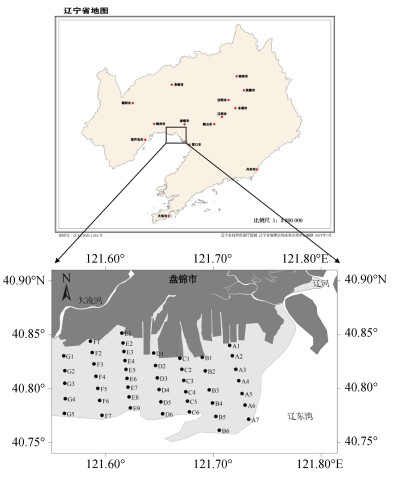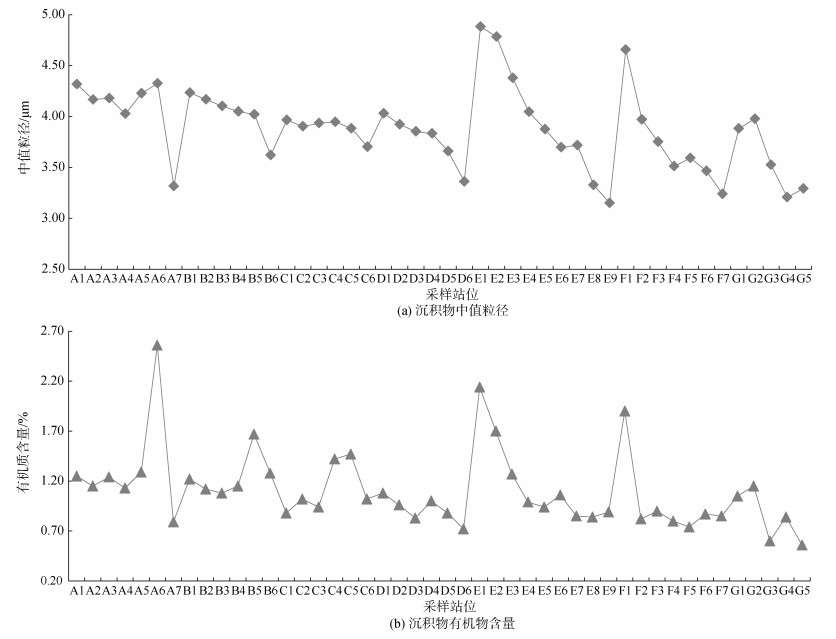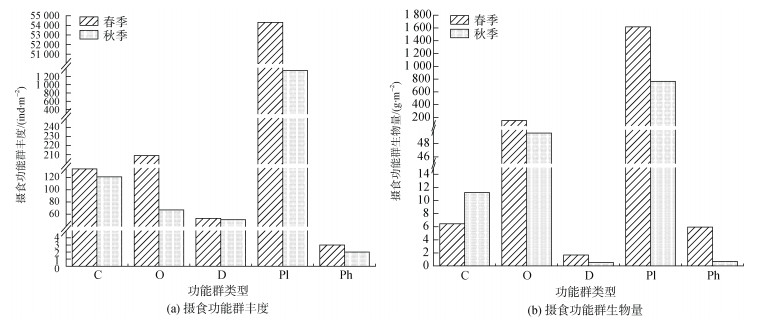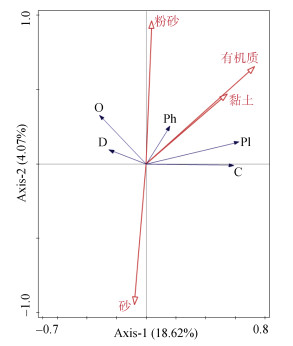
文章信息
- 孟翔, 袁秀堂, 张安国, 齐玥, 吴楠, 袁蕾, 康婧, 宋钢. 2023.
- MENG Xiang, YUAN Xiu-tang, ZHANG An-guo, QI Yue, WU Nan, YUAN Lei, KANG Jing, SONG Gang. 2023.
- 辽河口潮间带大型底栖动物摄食功能群特征研究
- Macrobenthos feeding functional groups in the intertidal flats of the Liaohe Estuary
- 海洋科学, 47(7): 111-121
- Marine Sciences, 47(7): 111-121.
- http://dx.doi.org/10.11759/hykx20220727001
-
文章历史
- 收稿日期:2022-07-27
- 修回日期:2022-09-05
2. 国家海洋环境监测中心, 辽宁 大连 116023;
3. 中国科学院烟台海岸带研究所, 山东 烟台 264003;
4. 锦州市龙海馨港科技有限公司, 辽宁 锦州 121209
2. National Marine Environmental Monitoring Center, Dalian 116023, China;
3. Yantai Institute of Coastal Zone Research of Chinese Academy of Sciences, Yantai 264003, China;
4. Jinzhou Longhaixingang Science and Technology Co., Ltd., Jinzhou 121209, China
潮间带滩涂是河口最为典型的生境之一, 具有丰富的边缘生态位和生物多样性特征[1-2]。大型底栖动物是河口潮间带滩涂生态系统的重要组成部分, 在河口生态系统物质循环和能量流动发挥着重要作用, 其资源动态和群落结构是重要研究内容之一[3-5]。
虽然大型底栖动物常被用于监测人类活动或自然因素引起的河口、海湾等生态系统变化[6-7], 但基于大型底栖动物群落结构对生境变化的响应并不一定能真实地反映实际情况[8]。大型底栖动物功能群方法可简化群落内物种之间的关系, 降低研究的复杂性[9]; 功能群方法弱化了物种在生态系统中的作用, 从而强调功能群的整体性, 能更好体现出底栖动物与其生存环境间的相互作用, 能更准确地反映其生境特征, 因此开展大型底栖动物功能群研究对分析生态系统功能具有意义[10-11]。目前, 国内外学者陆续使用功能群方法对大型底栖动物群落结构等内容进行了相关研究[12-13]。国内主要集中在长江口[14-17]、胶州湾[9]、莱州湾[18]、渤海湾[19-20]、浙江沿海地区[21-22]以及黄河口[23]等区域。而关于纬度更高的辽河口潮间带滩涂大型底栖动物功能群方面的研究却鲜有报道。
辽河口位于辽东湾北部, 是我国纬度最高的河口, 与我国其他河口相比, 结冰期长(近5个月)是其独有特征之一。此外, 辽河口潮间带滩涂大型底栖动物资源丰富, 并且是鸟类迁徙停歇或繁殖的重要场所之一[24]。因此, 辽河口区域生境特色鲜明、生物区系独特, 具有较高的代表性和科学研究价值[25]。本研究根据辽河口潮间带滩涂大型底栖动物现场调查数据, 初步分析了辽河口潮间带大型底栖动物摄食功能群结构组成特征、季节变化以及影响因素, 以期从摄食功能群角度来揭示辽河口潮间带大型底栖动物群落结构特征, 可为河口潮间带生物多样性保护和修复提供基础数据。
1 材料与方法 1.1 调查区域调查区域位于辽河口的辽河入海口西侧与大凌河入海口东侧之间的潮间带滩涂区域, 面积约为6 500 hm2。该区域是我国渤海目前少有的保留较为完好的滩涂生态系统之一, 贝类资源丰富, 也是鸟类的重要觅食区。
1.2 样品采集为全面反映调查区域情况, 按照垂直于海岸线方向在潮间带滩涂布设7条断面(A-G), 每个断面以低潮为基点向岸边辐射, 断面间距约为2.2 km。根据滩涂长度大小, 在同一断面布设5~9个站位, 最大程度地覆盖研究区域, 基本包含了高潮区、中潮区和低潮区, 站位间距离约为500 m, 共46个站位(图 1)。分别于2020年春(5月)和秋季(10月)大潮期进行2个航次的现场调查。大型底栖动物样品采集、保存等方法根据《海洋调查规范第6部分: 海洋生物调查》(GB/T12763.6—2007)[26]制定。在物种鉴定过程中, 根据《中国海洋生物名录》[27]确定物种中文名以及拉丁文名。每个站位设8个样方(25 cm×25 cm), 将样方内的沉积物(深度约20 cm)全部取出, 使用孔径为0.5 mm的网筛对大型底栖动物进行分选, 然后将分选出的大型底栖动物放入5%甲醛溶液固定保存, 物种鉴定、计数、称重均在实验室进行。
 |
| 图 1 2020年春秋季辽河口潮间带滩涂大型底栖动物采样站位示意图 Fig. 1 Sampling station location of macrobenthos in the intertidal flats of the Liaohe Estuary in the spring and autumn of 2020 |
在大型底栖动物样品采集的同时, 每站位采集未受人工扰动的沉积物样品100~200 g, 实验室内使用激光粒度仪对样品进行粒度分析, 测量范围在0.02~2 000 μm, 同时样品重复测试保证误差小于3%。沉积物中值粒径、平均粒径等沉积物粒度特征的统计参数使用福克/沃德公式计算得出, 再以沉积物中主次粒组≥20%为分类依据, 将滩涂底质分为4个底质类型组, 分别为粉砂、砂质粉砂、粉砂质砂和砂。在测量沉积物样品的有机质含量之前, 使用烘箱让沉积物样品在60 ℃中烘干72 h至恒重, 然后选取烘干的样品放入马弗炉, 在550 ℃下灼烧2 h后称重, 从而计算沉积物样品中有机质含量[28]。
1.3 摄食功能群划分本研究以大型底栖动物摄食器官的类型作为摄食功能群划分的主要依据, 并兼顾考虑其食物来源, 将辽河口潮间带滩涂大型底栖动物分为以下5种摄食功能群:
(1) 浮游生物食者(planktophagous group, Pl): 依靠特有的过滤器官滤食中小型浮游生物, 如双壳类和部分腹足类等[16, 18, 20]。
(2) 植食者(phytophagous group, Ph): 以小型海藻等水生植物为食, 如蟹类等[18]。
(3) 杂食者(omnivorous group, O): 主要以植物腐叶、腐肉、小型双壳类为食或通过皮肤或鳃的表皮吸收水体中的有机物, 如甲壳类[17-18, 29]。
(4) 肉食者(carnivorous group, C): 以捕食小型动物或动物幼体为主, 主要包括大部分环节动物及部分腹足类[17, 30]。
(5) 碎屑食者(detritivorous group, D): 能够吞食底表的有机碎屑和沉积物, 吸收其中的有机物质, 如少数甲壳类和多毛类等[16, 18]。
1.4 统计分析使用Microsoft Excel2010进行数据分析。通过无重复双因素方差分析(two-way ANOVA)来检验大型底栖动物摄食功能群群季节间的差异性, 显著性水平设置为0.05。Spearman相关分析与图表绘制在Origin 2021软件中进行。冗余分析(Redundancy analysis, RDA)在Canoco 5.0软件包中进行。
2 结果与分析 2.1 滩涂生境特征辽河口潮间带滩涂沉积物主要分为粉砂、砂质粉砂、粉砂质砂和砂4种类型。不同调查断面各沉积物粒度组成体积分数表现出一定的相似性, 且滩涂沉积物的中值粒径(Md)值总体上表现为从高潮带向低潮带逐渐减小的趋势, 变化范围为3.15~4.88 μm(图 2)。从高潮带向低潮带, 沉积物中有机质含量总体上表现为降低趋势, 变化范围为0.56%~2.56%(图 2)。
 |
| 图 2 2020年辽河口潮间带滩涂沉积物中值粒径及有机物含量状况 Fig. 2 Median grain size and organic matter of sediment in each sampling site of the Liaohe Estuary in 2020 |
春季和秋季两次采样总共获得46种大型底栖动物(表 1), 其中以环节动物最多, 共20种, 占潮间带滩涂大型底栖动物种类总数的43.5%; 软体动物次之, 共14种, 占种类总数的30.4%; 甲壳动物11种, 占种类总数的23.9%; 纽形动物最少, 仅1种, 占2.2%。主要优势种类为光滑河篮蛤(Potamocorbula laevis)、四角蛤蜊(Mactra veneriformis)、托氏琩螺(Umbonium thomasi)。
| 物种名 | 功能群 | 春季 | 秋季 |
| 环节动物Annelida | |||
| 长吻沙蚕Glycera chirori | C | + | + |
| 寡节甘吻沙蚕Glycinde gurjanovae | C | + | + |
| 囊叶齿吻沙蚕Nephtys caeca | C | + | + |
| 寡鳃齿吻沙蚕Nephtys oligobranchia | C | + | + |
| 中阿曼吉虫Armandia intermedia | D | + | + |
| 白色吻沙蚕Glycera alba | C | + | + |
| 双齿围沙蚕Perinereis aibuhitensis | O | + | + |
| 双唇索沙蚕Lumbrineris cruzensis | C | + | − |
| 加州齿吻沙蚕Nephtys californiensis | C | + | + |
| 锥唇吻沙蚕Glycera onomichiensis | C | + | + |
| 长锥虫Haploscoloplos elongates | D | + | + |
| 丝异须虫Heteromastus filiforms | D | + | + |
| 大盘扁虫Discloplana gigas | C | + | + |
| 膜质伪才女虫Pseudopolydora kempi | D | + | + |
| 叶须虫Phyllodocidae sp. | C | + | − |
| 头吻沙蚕Glycera capitata | C | + | + |
| 背蚓虫Notomastus latericeus | D | − | + |
| 玛叶须虫Phyllodoce malmgreni | C | − | + |
| 奇异稚齿虫Paraprionospio pinnata | D | − | + |
| 吻沙蚕属Glyceridae sp. | C | + | + |
| 甲壳动物Crustacea | |||
| 豆形拳蟹Philyra pisum | O | + | − |
| 朝鲜独眼钩虾Monoculode koreanus | D | + | + |
| 日本大眼蟹Macrophthalmus japonicus | Ph | + | + |
| 东方长眼虾Ogyrides orientalis | C | + | − |
| 圆球股窗蟹Scopimera globosa | Ph | + | − |
| 霍氏三强蟹Tritodynamia horvathi | C | + | − |
| 哈氏和美虾Nihonotrypaea harmandi | D | + | − |
| 宽身大眼蟹Macrophthalmus dilatatus | O | + | + |
| 中华虎头蟹Orithyia sinica | O | − | + |
| 三叶针尾涟虫Diastylis tricincta | D | − | + |
| 独眼钩虾Monoculode sp. | O | − | + |
| 软体动物Mollusca | |||
| 泥螺Bullacta exarata | O | + | + |
| 光滑河篮蛤Potamocorbula laevis | Pl | + | + |
| 青蛤Cyclina sinensis | Pl | + | + |
| 托氏琩螺Umbonium thomasi | Pl | + | + |
| 琵琶拟沼螺Assiminea lutea | Pl | + | + |
| 红明樱蛤Moerella rutila | Pl | + | + |
| 四角蛤蜊Mactra veneriformis | Pl | + | + |
| 秀丽织纹螺Nassarius festivus | C | + | + |
| 微黄镰玉螺Lunatia gilva | C | + | − |
| 文蛤Meretrix meretrix | Pl | + | + |
| 纵肋织纹螺Nassarius variciferus | C | + | + |
| 香螺Neptunea cumingi | C | − | + |
| 泰氏笋螺Terebra taylori | C | − | + |
| 毛蚶Scapharca kagoshimensis | Pl | − | + |
| 纽形动物Nemertea | |||
| 纽虫Nemertinea | C | + | + |
| 注: +表示该物种在相应季节有分布; −表示该物种在相应季节无分布; C代表肉食者; O代表杂食者; D代表碎屑食者; Pl代表浮游生物食者; Ph代表植食者。 | |||
辽河口潮间带滩涂大型底栖动物摄食功能群中肉食者种类数量最多, 为21种, 占总数的45.7%, 其代表性物种有长吻沙蚕(Glycera chirori)、寡节甘吻沙蚕(Glycinde gurjanovae)、秀丽织纹螺(Nassarius festivus)等; 其次为碎屑食者(9种), 占总数的19.6%, 其代表性物种有长锥虫(Haploscoloplos elongates)、三叶针尾涟虫(Diastylis tricincta)、中阿曼吉虫(Armandia intermedia)、丝异须虫(Heteromastus filiforms)等; 再次为浮游生物食者(8种), 占总数的17.4%, 其代表性物种有四角蛤蜊(M. veneriformis)、光滑河篮蛤(P. laevis)、托氏琩螺(U. thomasi)、琵琶拟沼螺(Assiminea lutea)等; 杂食者则有6种, 占总数的13.0%, 其代表性物种有泥螺(Bullacta exarata)、双齿围沙蚕(Perinereis aibuhitensis)等; 植食者种类数量最少, 仅有2种, 占总数的4.4%, 其代表性物种有日本大眼蟹(Macrophthalmus japonicus)、圆球股窗蟹(Scopimera globosa)。
2.3 摄食功能群丰度、生物量时空分布特征由表 2可知, 辽河口潮间带大型底栖动物各摄食功能群的丰度春季均高于秋季, 且浮游生物食者的丰度在春季和秋季均最高, 植食者均最低(表 2)。空间分布方面, 大型底栖动物各功能群在断面间无显著性差异, 但浮游生物食者在第B和C断面占据绝对优势。方差分析结果显示, 辽河口潮间带大型底栖动物功能群丰度在各摄食功能群及季节间均差异不显著。
| 类别 | 季节 | 肉食者C | 杂食者O | 碎屑食者D | 浮游生物食者Pl | 植食者Ph |
| 种类数 | 春季 | 18 | 4 | 6 | 7 | 2 |
| 秋季 | 16 | 5 | 8 | 8 | 1 | |
| 生物量/(g·m−2) | 春季 | 45.16 | 1 069.52 | 11.60 | 11 326.84 | 41.56 |
| 秋季 | 67.24 | 297.40 | 3.12 | 4 586.04 | 4.16 | |
| 丰度/(ind·m−2) | 春季 | 936 | 1 464 | 368 | 380 192 | 24 |
| 秋季 | 728 | 404 | 308 | 8 064 | 12 |
由图 3可知, 辽河口潮间带大型底栖动物各摄食功能群生物量(除肉食者外)均表现出春季高于秋季。其中, 浮游生物食者在春季和秋季时均最高, 其次为杂食者, 而碎屑食者生物量在春季和秋季时均最低。方差分析结果显示, 辽河口潮间带大型底栖动物摄食功能群生物量在各功能群及季节之间差异均不显著。
 |
| 图 3 2020年春、秋季辽河口潮间带大型底栖动物摄食功能群季节变化状况 Fig. 3 Seasonal variation of macrobenthic feeding functional group abundance and biomass in intertidal flats of Liaohe Estuary in spring and autumn of 2020 |
辽河口潮间带滩涂大型底栖动物5种摄食功能群与沉积物理化因子的Pearson相关分析结果显示: 肉食者与有机质含量存在显著的正相关(P < 0.05); 浮游生物食者与有机质含量和黏土含量存在显著的正相关(P < 0.05); 植食者与砂含量存在显著的负相关(P < 0.05), 与有机质含量、粉砂含量和黏土含量均存在显著的正相关(见表 3)。
| 肉食者C | 杂食者O | 碎屑食者D | 浮游生物食者Pl | 植食者Ph | |
| 有机质含量/% | 0.404 7* | −0.031 90 | −0.170 02 | 0.538 95* | 0.326 54* |
| 砂含量/% | −0.002 14 | −0.261 95 | 0.006 92 | −0.163 68 | −0.324 75* |
| 粉砂含量/% | −0.018 37 | 0.283 32 | 0.015 | 0.142 89 | 0.312 75* |
| 黏土含量/% | 0.240 18 | −0.069 14 | −0.259 89 | 0.354 26* | 0.362 35* |
| 注: *表示在0.05的水平下相关性显著 | |||||
冗余分析(RDA)结果表明, 沉积物中砂、粉砂、黏土含量和有机质含量与5种功能群前两个排序轴的相关性分别为0.720 4和0.435 3, 前两个排序轴累计可解释变异度为89.54%, 说明结果可信。由图 4可知, 黏土含量、有机质含量和砂含量影响各功能群丰度, 而且不同环境因子对不同功能群丰度的正负相关性有所不同。杂食者、碎屑食者主要与沉积物粉砂含量存在正相关关系; 浮游生物食者、肉食者与有机质含量之间存在正相关; 植食者与黏土含量、有机质含量以及粉砂含量呈正相关, 与砂含量存在负相关关系, 并与有机质含量相关性最高。
 |
| 图 4 2020年辽河口潮间带滩涂大型底栖动物摄食功能群丰度与环境因子的RDA排序图 Fig. 4 RDA ordination diagrams of macrobenthic feeding functional groups and environmental factors in the intertidal flats of Liaohe Estuary in 2020 注: Axis1和Axis2表示解释环境变异量贡献最大的两组。C代表肉食者; O代表杂食者; D代表碎屑食者; Pl代表浮游生物食者; Ph代表植食者 |
辽河口潮间带滩涂大型底栖动物摄食功能群种类数最多的为肉食者(表 4), 且主要为环节动物门类群, 其中优势类群长吻沙蚕(G. chirori)、寡节甘吻沙蚕(G. gurjanovae)对环境变化的适应性较强。辽河口海域富营养化严重, 沉积物中有机质含量丰富, 多毛类等肉食者能获得充足的食物来源, 有利于这些机会种的生存与发展。在莱州湾[18]、葡萄牙Tagus河口[31]等区域大型底栖动物物种组成中肉食者也占优势地位, 而在灵昆岛东滩和广州南沙潮间带主要为软体动物和甲壳类等植食者功能群[10, 30]。此外, 辽河口潮间带碎屑食者的种类数量也较高, 且主要是小型多毛类如丝异须虫(H. filiforms)。辽河口区域污染较严重[25], 可能导致耐有机污染的背蚓虫(N. latericeus)、丝异须虫(H. filiforms)等碎屑食者种类在该区域数量较多。另外, 浮游生物食者中个体较小的软体动物如光滑河篮蛤(P. laevis)占绝对优势地位。本研究发现, 辽河口潮间带滩涂植食者功能群种类数量极少, 在两个航次调查中只发现日本大眼蟹(M. japonicus)和圆球股窗蟹(S. globosa)这两种植食者种类, 造成此现象的原因可能是: 一方面, 由于辽河口潮间带区域浑浊度高, 限制了藻类的生长, 从而使得栖息于该生境的植食者种类数量少。另一方面, 辽河口潮间带缺少藻类等植物生长所需的硬相底质, 进而导致植食者功能群种类数量缺乏。辽河口潮间带滩涂植食者缺乏的现象与渤海湾研究结果较为一致[19]。
尽管辽河口潮间带滩涂大型底栖动物中肉食者和和碎屑食者在种类数量方面占主导地位, 但浮游生物食者则在丰度及生物量方面占优势地位。四角蛤蜊(M. veneriformis)作为浮游生物食者的优势种类之一, 其个体均较大, 生物量高。本次调查发现, 2020年四角蛤蜊在辽河口潮间带滩涂的平均生物量高达350.65 g/m2。同时, 光滑河篮蛤(P. laevis)和托氏琩螺(U. thomasi)等浮游生物食者优势种, 虽然个体小, 但丰度很高。本次调查结果显示, 光滑河篮蛤(P. laevis)和托氏琩螺(U. thomasi)在辽河口潮间带滩涂的平均丰度分别高达6 025 ind/m2和24 ind/m2。造成浮游生物者丰度和生物量高的原因可能主要是由于辽河及大凌河两条主要入海河流带来大量的颗粒有机物等营养物质, 并促进了浮游生物的生长。另外, 调查区域滩涂沉积生境以泥沙底质为主, 适合埋栖性滩涂贝类生存, 从而为四角蛤蜊(M. veneriformis)、光滑河篮蛤(P. laevis)等物种提供了成为优势种的机会。总之, 适宜的生境和丰富的食物来源最终导致浮游生物食者丰度和生物量较高, 此现象与象山港、浙江西门岛等区域的大型底栖动物功能群特征较为一致[32-33]。
另外, 本研究结果显示, 辽河口潮间带滩涂大型底栖动物各摄食功能类群的丰度和生物量在季节间均无显著差异。这可能是由于大部分大型底栖动物种类的生活史较长, 导致功能群季节变化不明显, 这与胶州湾[9]、莱州湾[18]、厦门近岸海域[34]等区域大型底栖动物摄食功能群的研究结果相一致。
3.3 辽河口潮间带大型底栖动物摄食功能群的环境影响因子不同环境因子对大型底栖动物不同功能群的影响是有差异的。沉积物有机质含量和粒度组成与大型底栖动物功能群的分布密切相关[35-37], 其中, 沉积物的粒度特征是影响大型底栖动物群落最直接的环境因素[38]。本研究发现, 辽河口潮间带滩涂浮游生物食者类群与有机质含量和沉积物中黏土含量均有显著的正相关关系, 并且浮游生物食者在靠近辽河入海口的第B和C断面占据绝对优势。即光滑河篮蛤(P. laevis)作为浮游生物食者的主要种类在断面B和C的丰度和生物量均占绝对优势, 如春季时, 光滑河篮蛤(P. laevis)在断面B和C的丰度高达12 028 ind/m2和23 551 ind/m2, 而在断面F和G断面仅为1 ind/m2和76 ind/m2。作为浮游生物食者的大型底栖动物来说, 丰富的食物来源一定程度上刺激了其丰度剧增而成为绝对优势种[20]。与其他断面所在区域不同, 在断面B和C区域的原有大部分高潮带区域均已围垦为养殖池塘, 大量的养殖尾水排放后会造成该滩涂区域的营养盐和有机质含量升高, 促进浮游植物的生长, 相应地造成该区域浮游植物生物食者占主要优势。本研究重点探讨了沉积物有机质及粒度组成等环境因子对大型底栖动物功能群的影响, 但水动力、盐度等其他环境因子均会对潮间带大型底栖动物产生影响[10, 32], 因此, 后续研究应增加盐度、水动力等环境因子的调查, 进而全面掌握环境因子与大型底栖动物摄食功能群的相互关系。
| [1] |
LIN Q Y, YU S. Losses of natural coastal wetlands by land conversion and ecological degradation in the urbanizing Chinese coast[J]. Scientific Reports, 2018, 8: 1-10. |
| [2] |
史会剑, 李玄, 王海艳, 等. 黄河三角洲潮间带大型底栖无脊椎动物群落结构与分布特征[J]. 海洋科学, 2021, 45(2): 11-21. SHI Huijian, LI Xuan, WANG Haiyan, et al. Community characteristics and spatial distribution of invertebrate macrobenthos in intertidal zone of the Yellow River Delta[J]. Marine Sciences, 2021, 45(2): 11-21. |
| [3] |
BEAUCHARD O, VERÍSSIMO H, QUEIRÓS A M, et al. The use of multiple biological traits in marine community ecology and its potential in ecological indicator development[J]. Ecological Indicators, 2017, 76: 81-96. DOI:10.1016/j.ecolind.2017.01.011 |
| [4] |
李宝泉, 姜少玉, 吕卷章, 等. 黄河三角洲潮间带及近岸浅海大型底栖动物物种组成及长周期变化[J]. 生物多样性, 2020, 28(12): 1511-1522. LI Baoquan, JIANG Shaoyu, LV Juanzhang, et al. Species composition and long-term variation of macrobenthos in intertidal zone and offshore areas of the Yellow River Delta[J]. Biodiversity Science, 2020, 28(12): 1511-1522. DOI:10.17520/biods.2020164 |
| [5] |
张镇, 董建宇, 孙昕, 等. 莱州芙蓉岛人工鱼礁区大型底栖动物营养结构特征研究[J/OL]. 水产学报, 2022. https://kns.cnki.net/kcms/detail/31.1283.S.20220429.1635.002.html. ZHANG Zhen, DONG Jianyu, SUN Xin, et al. Trophic structure of macrobenthos in artificial reef area of Furong Island, Laizhou Bay[J/OL]. Journal of Fisheries of China, 2022. https://kns.cnki.net/kcms/detail/31.1283.S.20220429.1635.002.html |
| [6] |
WALDRON A, MILLER D C, REDDING D, et al. Reductions in global biodiversity loss predicted from conservation spending[J]. Nature, 2017, 551: 364-367. DOI:10.1038/nature24295 |
| [7] |
YAN J, XU Y, SUI J X, et al. Long-term variation of the macrobenthic community and its relationship with environmental factors in the Yangtze River estuary and its adjacent area[J]. Marine Pollution Bulletin, 2017, 123(1/2): 339-348. |
| [8] |
BONIFÁCIO P, GRÉMAREA A, GAUTHIERC O, et al. Long-term (1998 vs. 2010) large-scale comparison of soft-bottom benthic macrofauna composition in the Gulf of Lions, NW Mediterranean Sea[J]. Journal of Sea Research, 2018, 131: 32-45. DOI:10.1016/j.seares.2017.08.013 |
| [9] |
辛俊宏, 任一平, 徐宾铎, 等. 胶州湾西北部潮滩湿地大型底栖动物功能群[J]. 应用生态学报, 2011, 22(7): 1885-1892. XIN Hongjun, REN Yiping, XU Binyi, et al. Macrozoobenthos functional groups in intertidal flat of northwest Jiaozhou Bay[J]. Chinese Journal of Applied Ecology, 2011, 22(7): 1885-1892. DOI:10.13287/j.1001-9332.2011.0271 |
| [10] |
葛宝明, 鲍毅新, 程宏毅, 等. 灵昆岛东滩潮间带大型底栖动物功能群及营养等级构成[J]. 生态学报, 2008, 28(10): 4796-4804. GE Baoming, BAO Yixin, CHENG Hongyi, et al. The trophic functional groups and trophic levels of the microbenthic community at the east tidal flat of Lingkun Island[J]. Acta Ecologica Sinica, 2008, 28(10): 4796-4804. DOI:10.3321/j.issn:1000-0933.2008.10.022 |
| [11] |
XU Y, FAN X P, WARREN A, et al. Functional diversity of benthic ciliate communities in response to environmental gradients in a wetland of Yangtze Estuary, China[J]. Marine Pollution Bulletin, 2018, 127: 726-732. DOI:10.1016/j.marpolbul.2017.12.068 |
| [12] |
GAMITO S, PATRICIO J, NETO J M, et al. Feeding diversity index as complementary information in the assessment of ecological quality status[J]. Ecological Indicators, 2012, 19: 73-78. DOI:10.1016/j.ecolind.2011.08.003 |
| [13] |
DOLBETH M, TEIXEIRA H, MARQUES J C, et al. Feeding guild composition of a macrobenthic subtidal community along a depth gradient[J]. Scientia Marina, 2009, 73: 225-237. DOI:10.3989/scimar.2009.73n2225 |
| [14] |
LV W W, ZHOU W Z, ZHAO Y L. Macrobenthos functional groups as indicators of ecological restoration in reclaimed intertidal wetlands of China's Yangtze Estuary[J]. Regional Studies in Marine Science, 2018, 22: 93-100. DOI:10.1016/j.rsma.2018.06.003 |
| [15] |
何鎏臻, 寿鹿, 廖一波, 等. 长江口及其临近海域大型底栖动物功能群演替初探[J]. 海洋与湖沼, 2020, 51(3): 477-483. HE Liuzhen, SHOU Lu, LIAO Yibo, et al. The succession of microbenthic functional groups in Changjiang River estuary and its adjacent waters[J]. Oceanologia et Limnologia Sinica, 2020, 51(3): 477-483. |
| [16] |
朱晓君. 长江河口潮间带湿地底栖动物功能群及其生态学意义研究[D]. 上海: 华东师范大学, 2004. ZHU Xiaojun. Functional groups and ecological significance research of benthos in the intertidal wetland, the Yangtze River Estuary[D]. Shanghai: East China Normal University, 2004. |
| [17] |
尤迪, 童春富, 吴逢润. 枯季长江口南汇东滩潮间带盐沼湿地冲淤变化对大型底栖动物功能群的影响[J]. 海洋学报, 2018, 40(8): 63-78. YOU Di, TONG Chunfu, WU Fengrun. Effects of sediment erosion and deposition variation on the benthic macroinvertebrate functional groups in an intertidal salt marsh of Nanhui Dongtan during the dry season, Changjiang River Estuary[J]. Haiyang Xuebao, 2018, 40(8): 63-78. DOI:10.3969/j.issn.0253-4193.2018.08.007 |
| [18] |
李少文, 刘元进, 李凡, 等. 莱州湾大型底栖动物功能群现状[J]. 生态学杂志, 2013, 32(2): 380-388. LI Shaowen, LIU Yuanjin, LI Fan, et al. Macrobenthic functional groups in Laizhou Bay, East China[J]. Chinese Journal of Ecology, 2013, 32(2): 380-388. |
| [19] |
徐飞, 王军强, 蔡文倩, 等. 天津近岸海域大型底栖动物摄食功能群特征及其与环境因子的关系[J]. 海洋与湖沼, 2021, 52(1): 186-195. XU Fei, WANG Junqiang, CAI Wenqian, et al. Macrozoobenthos functional feeding groups and its relationship with environmental factors in the Tianjin coastal area[J]. Oceanologia et Limnologia Sinica, 2021, 52(1): 186-195. |
| [20] |
蔡文倩, 林岿璇, 朱延忠, 等. 基于大型底栖动物摄食群上的生态质量评价[J]. 中国环境科学, 2016, 36(9): 2865-2873. CAI Wenqian, LIN Kuixuan, ZHU Yanzhong, et al. Assessment on the ecological quality based on the macrozoobenthos functional feeding groups[J]. China Environmental Science, 2016, 36(9): 2865-2873. DOI:10.3969/j.issn.1000-6923.2016.09.046 |
| [21] |
李欢欢, 鲍毅新, 胡知渊, 等. 杭州湾南岸大桥建设区域潮间带大型底栖动物功能群及营养等级的季节动态[J]. 动物学报, 2007, 53(6): 1011-1023. LI Huanhuan, BAO Yixin, HU Zhiyuan, et al. Seasonal dynamics of microbenthic functional groups and trophic levels in the bridge construction zone at the South Bank of Hangzhou Bay, China[J]. Acta Zoologica Sinica, 2007, 53(6): 1011-1023. DOI:10.3969/j.issn.1674-5507.2007.06.010 |
| [22] |
鲍毅新, 胡知渊, 李欢欢, 等. 灵昆东滩围垦区内外大型底栖动物季节变化和功能群的比较[J]. 动物学报, 2008, 54(3): 416-427. BAO Yixin, HU Zhiyuan, LI Huanhuan, et al. Seasonal variation and functional groups of microbenthic communities at diked and natural tidal flat, Lingkun Island, China[J]. Acta Zoologica Sinica, 2008, 54(3): 416-427. |
| [23] |
YANG W, LI X X, SUN T, et al. Macrobenthos functional groups as indicators of ecological restoration in the northern part of China's Yellow River Delta Wetlands[J]. Ecological Indicators, 2017, 82: 381-391. DOI:10.1016/j.ecolind.2017.06.057 |
| [24] |
ZHANG A G, YUAN X T, YANG X L, et al. Temporal and spatial distributions of intertidal macrobenthos in the sand flats of the Shuangtaizi estuary, Bohai Sea in China[J]. Acta Ecologica Sinica, 2016, 36(3): 172-179. DOI:10.1016/j.chnaes.2016.04.003 |
| [25] |
袁秀堂, 赵骞, 张安国. 辽东湾北部海域环境容量及滩涂贝类资源修复[M]. 北京: 科学出版社, 2021: 7-11. YUAN Xiutang, ZHAO Qian, ZHANG Anguo. Environmental capacity and shellfish resources restoration in northern Liaodong Bay[M]. Beijing: Science Press, 2021: 7-11. |
| [26] |
中华人民共和国国家质量监督检验检疫总局, 中国国家标准化管理委员会GB/T 12763.6—2007. 海洋调查规范第6部分: 海洋生物调查[S]. 北京: 中国标准出版社, 2007. General Administration of Quality Supervision, Inspection and Quarantine of the People's Republic of China GB/T 12763.6—2007, Standardization Administration of China. Specifications for oceanographic survey-Part 6: Marine biological survey[S]. Beijing: Standards Press of China, 2007. |
| [27] |
刘瑞玉. 中国海洋生物名录[M]. 北京: 科学出版社, 2008. LIU Ruiyu. Checklist of marine biota of China Seas[M]. Beijing: Science Press, 2008. |
| [28] |
杨纯懿, 张龙辉, 杜永芬, 等. 双台子河口砂质潮间带小型底栖动物的群落结构及其对环境的响应[J]. 海洋与湖沼, 2020, 51(3): 572-582. YANG Chunyi, ZHANG Longhui, DU Yongfen, et al. Meiofaunal community in sandy intertidal zone and its environmental response in Shuangtaizi estuary, Ne China[J]. Oceanologia et Limnologia Sinica, 2020, 51(3): 572-582. |
| [29] |
王琰, 童春富, 汤琳, 等. 崇明东滩盐沼湿地大型底栖动物功能群分布特征及其影响因子[J]. 生态学杂志, 2020, 39(3): 880-892. WANG Yan, TONG Chunfu, TANG Lin, et al. Distribution characteristics and influencing factors of the benthic macroinvertebrate functional groups in the salt marshes of Chongming Dongtan[J]. Chinese Journal of Ecology, 2020, 39(3): 880-892. |
| [30] |
颜露露, 蔡立哲, 陈昕韡, 等. 广州南沙十四涌潮间带大型底栖动物的功能群[J]. 生物多样性, 2016, 24: 802-810. YAN Lulu, CAI Lizhe, CHEN Xinwei, et al. Functional groups of benthic macrofauna in the 14th Yong intertidal zone of Nansha, Guangzhou[J]. Biodiversity Science, 2016, 24: 802-810. |
| [31] |
GAUD NCIO M J, CABRAL H N. Trophic structure of macrobenthos in the Tagus estuary and adjacent coastal shelf. Hydrobiologia, 2007, 587(1): 241-251.
|
| [32] |
尤仲杰, 陶磊, 焦海峰, 等. 象山港大型底栖动物功能群研究[J]. 海洋与湖沼, 2011, 42(3): 431-435. YOU Zhongjie, TAO Lei, JIAO Haifeng, et al. A survey of macrobenthos in the Xiangshan Bay[J]. Oceanologia et Limnologia Sinica, 2011, 42(3): 431-435. |
| [33] |
廖一波, 寿鹿, 曾江宁, 等. 浙江西门岛海洋特别保护区大型底栖动物功能群特征及其与环境的关系[J]. 生物多样性, 2013, 21(1): 3-10. LIAO Yibo, SHOU Lu, ZENG Jiangning, et al. Functional groups of marine macrobenthos in relation to environmental factors around the Ximen Island National Marine Special Reserve, Zhejiang[J]. Biodiversity Science, 2013, 21(1): 3-10. |
| [34] |
刘坤, 林和山, 何雪宝, 等. 厦门近岸海域大型底栖动物摄食功能群及其与环境因子的关系[J]. 海洋学报, 2016, 38(12): 95-105. LIU Kun, LIN Heshan, HE Xuebao, et al. Functional feeding groups of macrozoobenthos and their relationships to environmental factors in Xiamen coastal waters[J]. Haiyang Xuebao, 2016, 38(12): 95-105. |
| [35] |
董建宇, 孙昕, 詹启鹏, 等. 莱州湾东岸潮下带大型底栖动物群落beta多样性格局及其驱动因素[J]. 生物多样性, 2022, 30(3): 60-69. DONG Jianyu, SUN Xin, ZHAN Qipeng, et al. Patterns and drivers of beta diversity of subtidal macrobenthos community on the eastern coast of Laizhou Bay[J]. Biodiversity Science, 2022, 30(3): 60-69. |
| [36] |
何蕾, 华尔, 刘晓收, 等. 夏、秋季渤海小型底栖动物类群组成及分布特征[J]. 生态学报, 2019, 39(8): 2794-2805. HE Lei, HUA Er, LIU Xiaoshou, et al. Meiofauna assemblage composition and distribution in the Bohai Sea during summer and autumn[J]. Acta Ecologica Sinica, 2019, 39(8): 2794-2805. |
| [37] |
曲同飞, 侯承宗, 于子山, 等. 浒苔绿潮对青岛近岸潮间带底栖动物群落的生态效应[J]. 中国海洋大学学报(自然科学版), 2020, 50(12): 59-69. QU Tongfei, HOU Chengzong, YU Zishan, et al. Ecological effects of Ulva prolifera green tide on zoobenthos in Qingdao intertidal Area[J]. Periodical of Ocean University of China, 2020, 50(12): 59-69. |
| [38] |
王金叶, 张安国, 李晓东, 等. 蛤蜊岗滩涂贝类分布及其与环境因子的关系[J]. 海洋科学, 2016, 40(4): 32-39. WANG Jinye, ZHANG Anguo, LI Xiaodong, et al. Spatial distribution of buried molluscs and their relationship with sediment factors in Geligang[J]. Marine Sciences, 2016, 40(4): 32-39. |
 2023, Vol. 47
2023, Vol. 47


